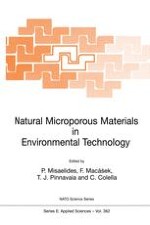1999 | OriginalPaper | Chapter
Zeoponic Substrates for Space Applications: Advances in the Use of Natural Zeolites for Plant Growth
Authors : D. W. Ming, E. R. Allen
Published in: Natural Microporous Materials in Environmental Technology
Publisher: Springer Netherlands
Included in: Professional Book Archive
Activate our intelligent search to find suitable subject content or patents.
Select sections of text to find matching patents with Artificial Intelligence. powered by
Select sections of text to find additional relevant content using AI-assisted search. powered by
Natural zeolites have unique physical and chemical properties, which make them attractive for use in slow-release fertilisation for plants, zeoponic plant growth substrates, and soil conditioning and remediation. Zeoponic substrates are defined as artificial soils in which zeolites are a major component. Over the past 10 years, the National Aeronautics and Space Administration (NASA) has been developing a zeoponic substrate for plant growth in space. The primary zeolite used in these substrates is clinoptilolite, because of its selectivity for K+ and NH4+ and its stability in soil-based systems. In addition to NH4- and K-exchanged clinoptilolite, substrates developed by NASA contain either natural or synthetic apatite. Slow-release fertilisation has been achieved in this system by dissolution of either natural or synthetic apatite and cation exchange reactions of clinoptilolite. The synthetic apatites are hydroxyapatites in which Mg, S, and the micronutrients have been substituted into its structure for either Ca and PO4. Hence, these substrates have the capability of supplying all of the essential plant growth nutrients with only the addition of water.In several NASA studies, wheat grown in zeoponic substrates produced greater total dry matter as compared to wheat grown in control substrates watered with nutrient solutions. In another study, however, significantly less wheat grain was produced by plant grown in zeoponic substrates compared to plants grown in control substrates, and this was attributed to reduced seed set caused by the NH4-N source from clinoptilolite exchange. In a subsequent study, the addition of nitrifying bacteria and dolomite to zeoponic substrates produced higher wheat seed yields than control substrates, suggesting that the nitrifying bacteria converted NH4-N to NO3-N, which is more likely to enhance seed set. In a recent plant-growth chamber study, wheat seed production from plant grown in a hydroponic system slightly out performed a zeoponics system; however, the seed production from plants grown in the zeoponics substrate was equivalent to approximately 200 bushels/acre, substantially higher than yields obtained in the field.Wheat and brassica have been grown in zeoponic substrates on the U.S.A. Space Shuttle. During an 8-day flight the growth and development of both plant species on orbit appeared normal and similar to those of plants grown in ground controls. Zeoponic substrates may be used for long-term, plant growth experiments on the International Space Station.Several companies in the United States are marketing zeoponic or zeolite-based products, primarily for the golf industry. One company has developed a zeoponic substrate called “ZeoPro™”, which is being used as a slow-release fertiliser on golf greens. Because of the recent progress made in the development of zeoponic substrates, we anticipate that the application of zeoponic substrates in the horticultural, agricultural, and turfgrass industries will significantly increase over the next few years. It is likely that these products will be used to improve fertiliser-use efficiency and in environmental protection. With continued sound scientific research, it is likely that zeolites will be used extensively in the plant growth industry during the first part of 21st century.
